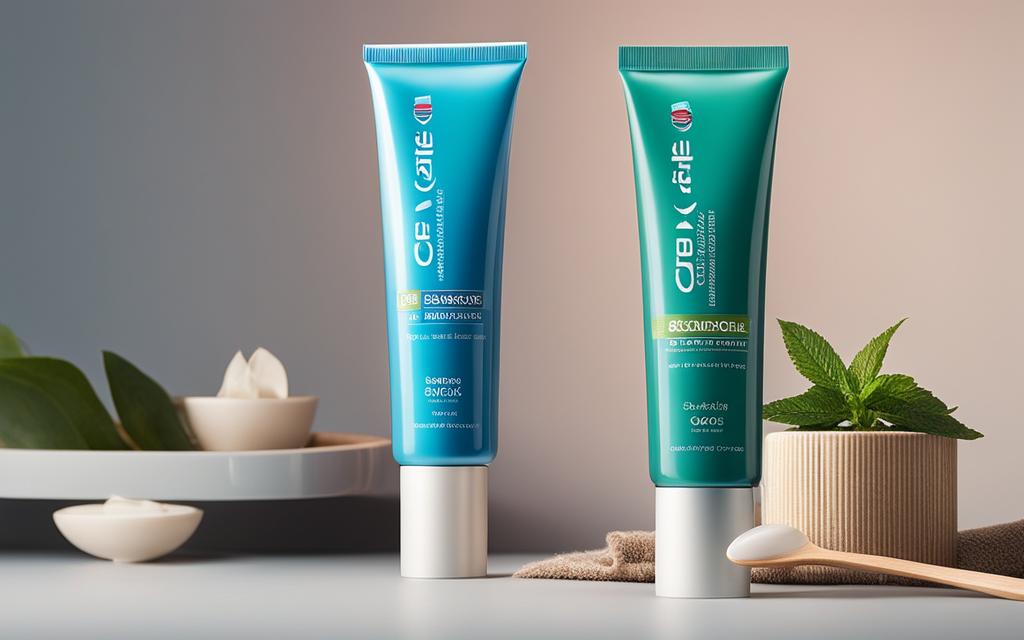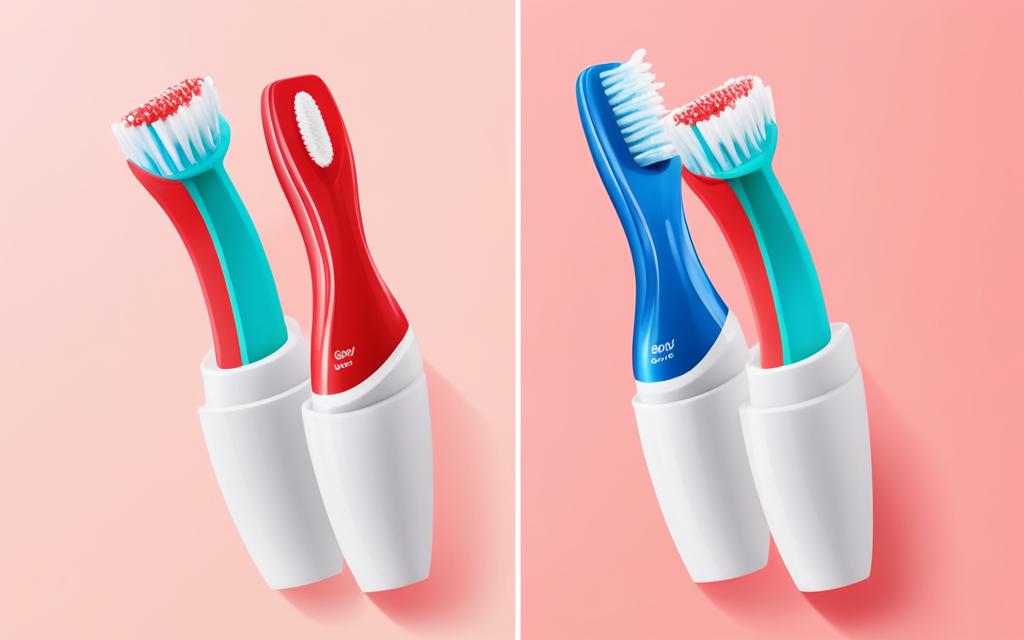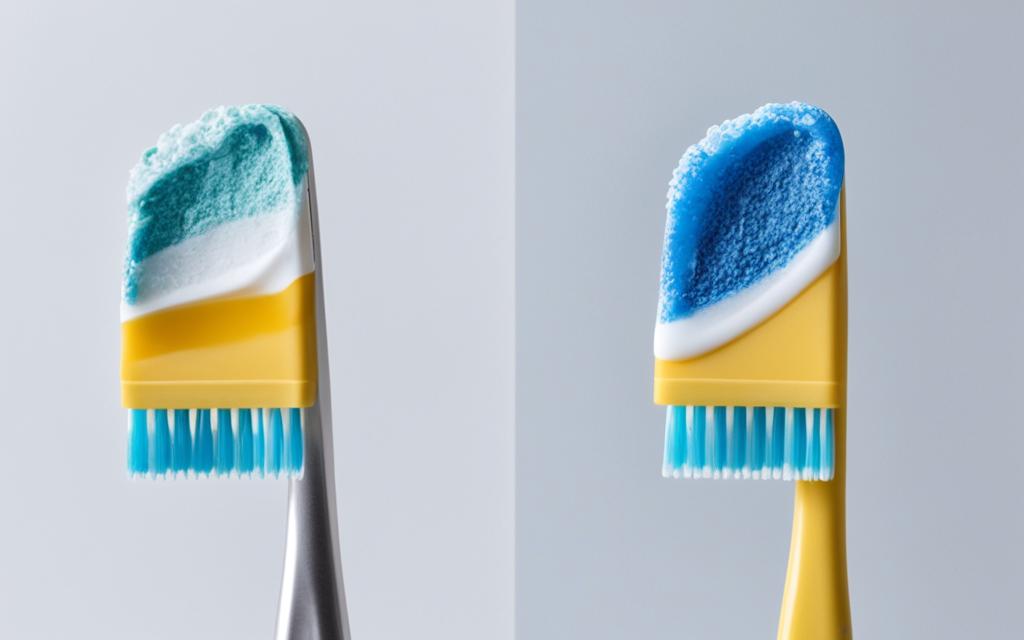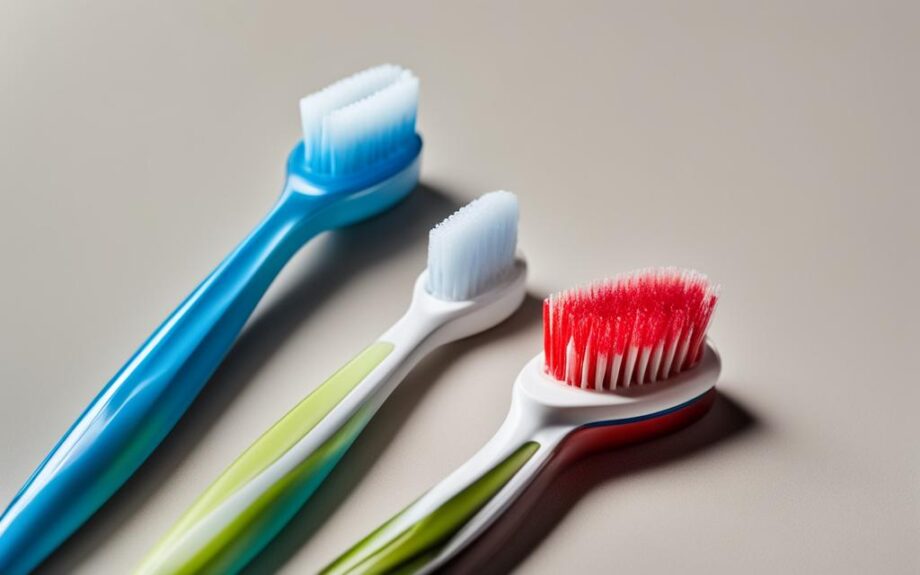When it comes to selecting the right toothpaste, the choice between gel vs paste toothpaste can be a daunting one. With an overwhelming variety of toothpaste options available, it’s tough to determine which is best suited for your dental routine.
In this section, we’ll explore the differences between gel and paste toothpaste so you can make an informed decision for healthier teeth and gums. We’ll also highlight the pros and cons of each type and offer tips on how to optimize your dental routine with either gel or paste toothpaste.
Key Takeaways:
- Understanding the differences between gel and paste toothpaste can help you choose the best option for your dental needs.
- Gel toothpaste may be a better choice for individuals with sensitive teeth or who desire whitening benefits.
- Paste toothpaste may be more effective in preventing cavities.
- Consider personal preference, dental needs, and expert recommendations when choosing between the two.
- Consistency and frequency of use are crucial components of a healthy dental routine.
What is the Difference Between Gel and Paste Toothpaste?
Gel and paste toothpaste are two of the most common varieties of toothpaste available on the market. While both serve the same basic function of keeping your teeth and gums clean, there are some key differences between the two types. Here, we’ll take an in-depth look at the differences between gel and paste toothpaste to help you better understand which type might be best for you.
Texture and Consistency
The main difference between gel and paste toothpaste lies in their texture and consistency. Gel toothpaste has a smoother, more slippery texture than paste toothpaste, which is thicker and more substantial. This difference in texture can affect your brushing experience. Some people prefer the smoothness of gel toothpaste, while others like the feeling of the paste toothpaste better.
Ingredients
Gel and paste toothpaste generally contain the same basic ingredients, such as fluoride, abrasives, and detergents. However, the specific makeup of each type can vary slightly. Gel toothpaste often contains more humectants, which help to keep the toothpaste from drying out. On the other hand, paste toothpaste may contain more binders and thickeners to help it maintain its shape.
Effectiveness
The effectiveness of gel and paste toothpaste in cleaning your teeth is generally comparable. However, some people may find that one type works better for them than the other. For example, if you have sensitive teeth, you may find that gel toothpaste is a better option for you, as it tends to be less abrasive than paste toothpaste. Alternatively, if you’re looking for a toothpaste that will help to whiten your teeth, you may find that paste toothpaste is more effective.
Overall, the choice between gel and paste toothpaste comes down to personal preference and individual dental needs. While there are some differences between the two types, both can effectively clean your teeth and keep your gums healthy with proper use.
Pros and Cons of Gel Toothpaste
Gel toothpaste versus paste toothpaste is an ongoing debate, and it can be challenging to choose which one is the best option for you. Let’s take a closer look at the pros and cons of using gel toothpaste.
Pros of Gel Toothpaste
- Gel vs paste toothpaste for sensitive teeth: Gel toothpaste is typically smoother and less abrasive than paste toothpaste, which makes it an optimal choice for individuals with sensitive teeth. As it contains no scrubbing agents, it’s gentler on the teeth and gums, making brushing more comfortable and minimizing the possibility of damage.
- Gel vs paste toothpaste for whitening: Gel toothpaste contains specific whitening agents that help to eliminate surface stains and lighten the teeth, leaving you with a brighter, more radiant smile. For best results, look for a gel toothpaste that includes hydrogen peroxide or carbamide peroxide.
Cons of Gel Toothpaste
- Possible drawbacks related to texture: Some users may find that gel toothpaste is too runny or doesn’t cling to the toothbrush as well as paste toothpaste, making it more challenging to get the desired amount of product onto the brush. Additionally, gel toothpaste tubes tend to be more challenging to squeeze out all of the toothpaste resulting in waste.
- Limited options for cavity prevention: Gel toothpaste’s texture makes it less effective in removing the bacteria that causes cavities than paste toothpaste. If cavity prevention is a significant concern, your dentist may recommend opting for a paste toothpaste that contains fluoride to help strengthen and protect your teeth.

Overall, gel toothpaste is a fantastic option for those with sensitive teeth or those looking to brighten their smile. However, it may not be the best choice for those focused on cavity prevention or who prefer a thicker toothpaste texture.
Pros and Cons of Paste Toothpaste
In contrast to gel toothpaste, paste toothpaste has a thicker consistency and contains more abrasive particles that can effectively remove plaque. It is also known for its cavity-fighting properties, making it a popular choice for those concerned about oral health.
Pros of Paste Toothpaste
- Cavity Prevention: The abrasiveness of paste toothpaste helps remove plaque buildup and prevent tooth decay.
- Availability: Paste toothpaste is widely available in different brands and flavors, making it easy to find and purchase.
- Familiarity: Many people are accustomed to using paste toothpaste and feel more comfortable with its texture and consistency.
Cons of Paste Toothpaste
- Sensitivity: The abrasive particles in paste toothpaste can cause tooth sensitivity or even damage the enamel if used excessively.
- Less Suitable for Whitening: While it may effectively remove surface stains, paste toothpaste is generally less effective in whitening teeth compared to gel toothpaste.
- Clumping: The thicker consistency of paste toothpaste tends to clump, making it less easy to spread across the teeth and gums.

In summary, paste toothpaste is a solid choice for cavity prevention, but it may not be the best option for those with sensitive teeth or those looking for a whitening boost. Always consult with your dentist or dental hygienist to determine the best toothpaste for your individual dental needs.
Choosing Between Gel and Paste Toothpaste
Now that you know the differences between gel and paste toothpaste, it’s time to choose which one is best for you. Here are some factors to consider:
- Personal preference: Do you prefer a smooth texture or a grainy one? A minty flavor or something more subtle?
- Specific dental needs: Are you primarily concerned with preventing cavities, or are you looking for a toothpaste that will help whiten your teeth?
- Expert recommendations: Consult with your dentist or dental hygienist to determine which type of toothpaste is most suitable for your oral health.
Ultimately, the choice between gel and paste toothpaste is a matter of personal preference and specific dental needs. Consider the information provided in this article, and don’t be afraid to try both types to see which one works best for you.

Remember, no matter which type of toothpaste you choose, maintaining a consistent oral care routine is key to achieving and maintaining optimal dental health.
Enhancing Your Dental Routine for Healthier Teeth and Gums
Using the right toothpaste is just the first step towards maintaining optimal dental health. Here are some practical tips and advice on how to optimize your dental routine using gel or paste toothpaste.
Brushing Technique
The American Dental Association (ADA) recommends brushing twice a day, using a pea-sized amount of toothpaste and a soft-bristled toothbrush. While using gel or paste toothpaste is a personal choice, it’s important to ensure that you use the correct brushing technique. Avoid brushing too hard, as it can damage your tooth enamel and gums. Instead, make gentle, circular motions on each tooth, making sure to clean the outer, inner and chewing surfaces.
Frequency of Use
Most dentists recommend brushing your teeth twice a day – once in the morning and once before bed. However, depending on your specific dental needs, you may need to brush your teeth more frequently. If you’re prone to cavities, for example, you may need to brush your teeth after every meal. Using a fluoride-based toothpaste can also help in preventing cavities, regardless of whether you’re using gel or paste toothpaste.
Additional Oral Care Practices
Using mouthwash and flossing your teeth regularly can also help to maintain healthy teeth and gums. Mouthwash can help to kill any bacteria that might be lurking in your mouth and boost your overall oral hygiene. Flossing your teeth can remove any food debris that’s stuck in difficult-to-reach areas, preventing potential cavities and gum disease.
Tip: To ensure a complete and thorough clean, consider an electronic toothbrush.
| Gel Toothpaste | Paste Toothpaste | |
|---|---|---|
| Texture | Gel-like consistency | Thicker, more solid-like consistency |
| Flavors | Often comes in fruity or minty flavors | Comes in more traditional mint or menthol flavors |
| Sensitivity | Can be less abrasive and suitable for sensitive teeth | May contain more abrasive ingredients and less suitable for sensitive teeth |
| Whitening Capabilities | May contain ingredients such as hydrogen peroxide or baking soda for whitening benefits | May contain enamel-strengthening ingredients such as fluoride and calcium carbonate |
Choosing Between Gel and Paste Toothpaste for Your Oral Needs
When choosing between gel and paste toothpaste, it ultimately comes down to personal preference and your specific oral care needs. Gel toothpaste may be best suited for individuals with sensitive teeth, as it’s typically less abrasive. If you’re looking for a toothpaste that offers whitening benefits, gel toothpaste may also be a better option. However, if you’re looking for a toothpaste that can help to prevent cavities, paste toothpaste may be your best bet.
Regardless of whether you choose gel or paste toothpaste, remember to maintain a consistent dental hygiene routine. Regular brushing, flossing and the use of mouthwash can help to keep your teeth and gums healthy and strong in the long run.
Conclusion
Choosing the right toothpaste, whether it’s gel or paste, can be an important decision for your dental health. Through our comparison of gel vs paste toothpaste, we hope to have provided you with the necessary information to make an informed choice that works best for your dental needs and preferences.
While gel toothpaste may be better suited for individuals with sensitive teeth and offer potential whitening benefits, paste toothpaste may be more effective in cavity prevention.
Ultimately, the right toothpaste for you depends on a variety of factors, from your oral health goals to personal taste and preference. Be sure to consult with your dentist or dental professional to get recommendations specific to your needs.
Remember, no matter which type of toothpaste you choose, maintaining consistent oral care practices, including brushing twice a day and flossing regularly, is essential for achieving optimal dental health.
Thank you for reading our article on the comparison of gel vs paste toothpaste. We hope you found it helpful in making your decision. Stay tuned for more informative articles on dental health and wellness!
FAQ
What is the difference between gel and paste toothpaste?
Gel toothpaste has a smoother, gel-like texture, while paste toothpaste has a thicker, more paste-like consistency. Gel toothpaste often contains fewer abrasive particles and may be more suitable for individuals with sensitive teeth.
What are the pros and cons of gel toothpaste?
Gel toothpaste is known for its ability to effectively clean teeth and freshen breath. It can be gentle on sensitive teeth and gums. However, some individuals may not find it as satisfying as paste toothpaste due to its lack of foaminess and thicker consistency.
What are the pros and cons of paste toothpaste?
Paste toothpaste, with its foaming action and thicker consistency, provides a satisfying brushing experience. It is often favored by individuals who enjoy the traditional texture and feel of toothpaste. However, some paste toothpaste may contain more abrasive ingredients, which may not be suitable for those with sensitive teeth or gums.
How do I choose between gel and paste toothpaste?
Deciding between gel and paste toothpaste ultimately depends on personal preference and dental needs. If you have sensitive teeth or gums, gel toothpaste may be a better option. If you prefer a foamy, traditional brushing experience, paste toothpaste may be more suitable. Consulting with your dentist can also provide valuable insights and recommendations.
How can I enhance my dental routine using gel or paste toothpaste?
Regardless of whether you choose gel or paste toothpaste, it is essential to brush your teeth at least twice a day and floss daily. Use a soft-bristled toothbrush and apply a pea-sized amount of toothpaste to the brush. Brush in circular motions for two minutes, ensuring to reach all surfaces of your teeth and gums. Don’t forget to visit your dentist regularly for professional cleanings and oral examinations.
